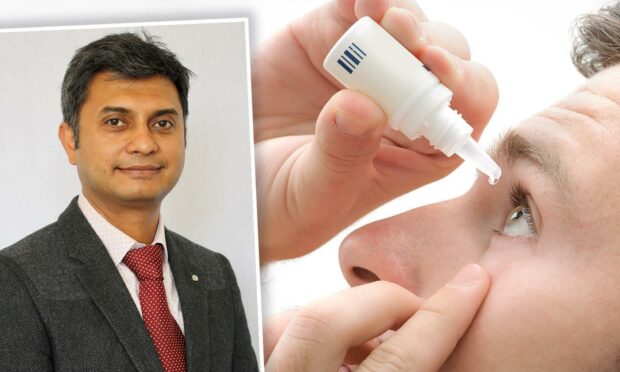Around 80 million people worldwide have glaucoma and, unaware of the signs, many find themselves facing gradual “silent blindness”.
The irreversible eye condition affects around 500,000 people in the UK, and this number is predicted to soar to more than 700,000 by 2035.
Today marks the start of World Glaucoma Week, with campaigns globally raising awareness of the signs and treatments for the illness.
Aberdeen ophthalmologist Sudipto Bhatta, who has 18 years of experience, says he often speaks to patients who aren’t aware they are already suffering the effects of glaucoma.
“[They say] ‘my sight is perfect and I don’t have any problems in seeing at a distance,” he explained.
“In reality, a proportion of their side vision has already been lost.”
Mr Bhatta, who works at Albyn Hospital in Aberdeen, has answered some of the most common questions about glaucoma for us – urging people to pay close attention to their eye health.
So, what is glaucoma?
Sometimes the natural drainage of the internal fluid in your eyes can become backed up – increasing the pressure inside.
Over time, this can lead to damage of the optic nerve and potentially the loss of some peripheral vision.
Mr Bhatta said: “This often goes unnoticed in the early stages – for example with cars approaching from the side while driving, or children in a park suddenly appearing from the corner of your vision.”
If untreated, it can continue to deteriorate with tunnel vision and, in the most extreme cases, blindness.
What can we do about it?
Early diagnosis is the key to treat glaucoma successfully, Mr Bhatta says.
“My simple recommendation is to attend one’s own optician for regular yearly sight tests after the age of 45.
“The optician can spot elevated eye pressure and refer patients to the consultant in the hospital where more specialised tests are carried out.”
In turn, catching sight problems early means people can be referred to specialists sooner – preventing conditions from deteriorating and requiring more healthcare resources to remedy.
How can we treat glaucoma – and what is new?
There are several successful treatments available to delay the progression and prevent blindness from glaucoma.
Pressure-reducing eye drops, laser treatment and surgery are the most common options.
But one new trend is to use tiny titanium gadgets – the smallest medical devices known to be implanted into the human body – to help regulate the pressure in the eye.
The iStent injections are just 0.36mm long, roughly the size of a large grain of sand, and can be inserted quickly under local anaesthetic.
“This device has an excellent safety profile,” Mr Bhatta explained.
“In appropriate patients, it can be conveniently combined with a simple cataract surgery with very little additional surgical time and can effectively reduce eye pressure which could delay the worsening of their glaucoma.”


